(Interesting information for the Krsna conscious/Indian history buff)
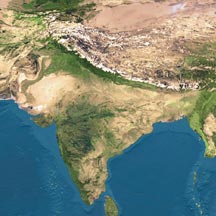 “Who Ruled India?” is an interesting question. The history of rule in India goes back to great antiquity, back and back to the days of the Mahabharata (emperors such as Yudhisthira and Pariksit Maharaja) and before that to the days of the Ramayana when Sri Ramacandra sat on the throne of Ayodhya. Those days and subsequent times were known as the rule of rama-rajya, the saintly rulers of India. In those days India spread in the west as far as the Caspian Sea and in the east along the borders of the Himalayas to present day Burma. But the geographical borders of India have changed many times since then and so have her rulers.
“Who Ruled India?” is an interesting question. The history of rule in India goes back to great antiquity, back and back to the days of the Mahabharata (emperors such as Yudhisthira and Pariksit Maharaja) and before that to the days of the Ramayana when Sri Ramacandra sat on the throne of Ayodhya. Those days and subsequent times were known as the rule of rama-rajya, the saintly rulers of India. In those days India spread in the west as far as the Caspian Sea and in the east along the borders of the Himalayas to present day Burma. But the geographical borders of India have changed many times since then and so have her rulers.
In recent history we remember British, French and Portuguese rule in India. A little further back than that we remember the Mogul or Islamic rule in India. But for most of us our knowledge of who ruled in India becomes a little hazy when we try to think prior to the Mogul period. Indeed, we may be shaken from our slumber when we hear that Persian, Greek, Chinese and even Ethiopians ruled in India and contributed to the development of India as a culture and a country.
Indeed, the Vana-parva of Mahabharata contains verses in the form of prophecy complaining that, "Mlechha (Barbaric) kings of the Sakas (nomadic tribesmen residing in and migrating over the plains of Eurasia from Eastern Europe, from Siberia in Russia, from Xinjiang Province, China), Yavanas (Greeks), Kambojas (from Central Asia/Iran), etc. shall rule the earth (i.e. India) un-righteously in Kali-yuga" And there would be others also.
Manu-smrti lists Yavanas, Kambojas, Sakas, Pahlavas, etc. and regards them as degraded ksatriyas. Anushasana-parva of Mahabharata also views the Yavanas, Kambojas, Sakas etc. in the same light. Patanjali's Maha-bhasya regards the Yavanas and Sakas as anirvasita (pure sudras). The Gautama-Dharma-sutra regards the Yavanas or Greeks as having sprung from sudra females and ksatriya males.
The Assalayana Sutta of the Majjhima Nikaya attests that in Yona (Yavana) and Kamboja nations, there were only two classes of people, Aryas and Dasas (the masters and slaves) and that the Arya could become Dasa and the Dasa become Arya. The Visnu Purana also indicates that the catur-varna, or four class social system was absent in the lands of Kiratas in the East (Tibet and China) and in the lands of the Yavanas and Kambojas in the West.
The Harivamsa attests that the clans of Yavanas, Kambojas, Sakas, Pahlavas etc. were "formerly noble ksatriyas". Manu-smrti says that the Yavanas and Kambojas became degraded as ksatriyas because they failed to perform the Vedic rites and became disrespectful to the brahmana communities in their countries. The Mahabharata likewise notes that the Yavanas, Kambojas, Sakas, and Pahlavas were originally "noble ksatriyas", who later got degraded to barbaric status due to the wrath of the brahmanas.
Numerous Puranic literatures group the Yavanas, Sakas, Kambojas, Pahlavas, etc together and refer to the peculiar hair styles of these people, which was different from those of the men of central India, who kept long hair and top knots. Ganapatha, while commenting on Panini, says that it was a practice among the Yavanas and the Kambojas to wear short-cropped hair, (kamboja-mundah yavana-mundah), a practice that has become common among almost all men in India today.
Brhat-Katha-Manjari of Ksmendra tells us that king Vikramaditya rid the sacred earth of the barbarians, like the Sakas, Kambojas, Yavanas, Tusaras, Parasikas, Hunas, etc, by “completely annihilating these sinners”. But as the saying goes, “evil things and their influences never die” – they came again and again.
Over the past three millenniums there have been many foreign rulers in India and influences left behind by them. It becomes difficult sometimes to say what is actually Indian. Some examples would be the contemporary choli, short hair style for men, the harmonium, sitar, chilies, tomatoes, etc, as well as influences in art, music, language, medicine, architecture and even philosophy. Many such things are commonly accepted as indigenous to India or being ‘Indian’, when in fact they are not.
Srimad Bhagavatam gives us a list of kings who ruled in India according to strict Vedic principles during the first 1000 years of Kali-yuga. After that 1000-year period the rulers in India went into sharp decline, resulting in weaker and weaker kingdoms with soft borders — thus entered the foreign conquerors. However, by this time in history everything west of the Indus River was already considered as the Persian Empire and not part of India.
In the ancient world the Persians of the 1st millennium BCE ruled parts of India that we now call Afghanistan, Iran, Iraq, and Syria. Dates assigned by modern scholars for this period and those assigned by Vedic and Puranic sources differ greatly and are not easy to reconcile. But in any case India was not actually called India before 2500 years ago, it was called Bharata-varsa, a Sanskrit name meaning the region once ruled by Bharata Maharaja, son of Rsabhadeva. India being an English word is actually derived from the older Greek word Indika, referring to the land of the Indus Valley.
In antiquity the borders of Bharata-varsa extended to the Caspian Sea in the west, in the north it included what we now call Tajikistan, Kyrgyzstan, Turkmenistan, Uzbekistan, Kazakhstan and beyond and, as already stated, in the east the borders of Bharata-varsa reached up to Burma.
Of course, according to some thinking, once upon a time the Vedic culture was spread all over the world, but in the places that I have mentioned above it has definitively been proven by archaeological discoveries that the Vedic culture existed in those lands 5000 years ago and possibly before.
PERSIANS
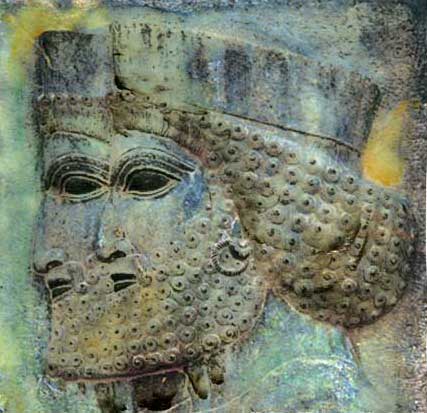
Stone Carving of Persian King
The first rulers, other than the Vedic kings, to rule over a vast area of Bharata-varsa were the Persians. The Persians however were not actually foreigners but people who came to abandon Vedic rites and philosophy. Persia declined in status within the Vedic society first due to their offenses to the brahmanas and later by wholesale conversion to Zoroastrianism. This was an internal event within the borders of Vedic society that occurred without any outside influence. The first degradation occurred when the ksatriyas offended the brahmanas and were thus cursed to become sudras. Later Zoroaster (half brother of Vasistha Muni) entered the scene and converted a local king named Vishtaspa. Zoroaster emphasized that good and evil are separate entities (Ormuzd and Ahriman) at war with each other, but that both Deities ultimately descended from the Wise Lord, Ahura Mazda. Zoroaster’s belief, although monotheistic, held many opinions that were diametrically opposed to the Vedic knowledge. Soon Zoroaster’s teachings became state doctrine and a new kingdom was born. It took time but the end result was that half of Bharata-varsa became permanently deviated from the Vedic concepts. This happened even before the Kali-yuga began and remains so to the present day.
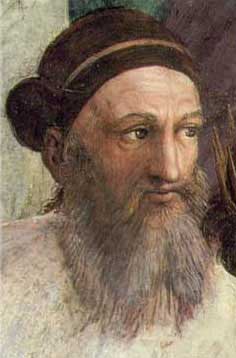
Zarathustra
Bhaktivinoda Thakura comments on Zoroastrianism as follows: Zarathustra (Zoroaster) is a very ancient philosopher. When his philosophy found no honor in India, Zarathustra preached in Iran. It was by the influence of Zarathustra’s ideas that Satan, an equally powerful rival to God, made his imaginary appearance first in the religion of the Jews and then in the religion based on the Koran. Then, influenced by Zarathustra's idea of two Gods, the idea of three gods, or a ‘Trinity’ made its appearance in the religion (Christianity) that had come from the Jewish religion. (Tattva-viveka 1.21)
GREEKS
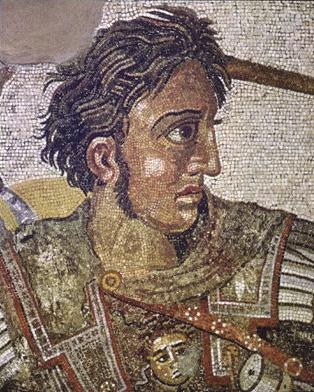
Alexander the Great
Next came the Greeks led by Alexander the Great (‘Great’ or ‘Infamous’ — depending on who’s writing the history), who defeated the Persians and eventually made his way across Persia to India and conquered some of the territories along her borders in what is now Pakistan and the Punjab. This began what historians call the Indo-Bactrian period and therein begins an exchange of ideas between east and west that continues up to our present time. Alexander’s career more or less came to a halt after his brief encounter with Raja Porus (Puru) of India. Alexander defeated Porus at the battle of Hydaspes (326 BCE). Afterward, Alexander and his troops (on the verge of mutiny), worn by years of battle decided to return home to Greece. Alexander never made it home. He died in Babylon (Iraq) in 323 BCE. The kingdom that Alexander had created then divided and the Indian portion of the kingdom east of the Indus passed back to Indian control, to Chandragupta, the first Maurya emperor.
The Greeks however again pushed into India and had some success setting up cities and ruling as kings for quite sometime in places like the city of Taxila (located in present day Pakistan). Taxila had been a city of fame and learning since at least five centuries BCE. Taxila is supposed to have been the city of King Taksa, son of Bharata and Mandavi in Ramayana. During and after the time of Greek occupation in Taxila it continued to be famous as a place of learning. Some theorists are even of the opinion that Jesus of Nazareth studied in Taxila during his youth. In any case Taxila was famous during the Indo-Greek period as a place of learning and it was indeed visited by peoples from the Mediterranean and from even as far away as China.
Most contemporary scholars, and indeed even the ancients of India such as Emperor Asoka, considered the Greeks to be Yavanas and mention them as such in numerous places such as the Edicts of Asoka wherein the Greek kings to the far west are associated unambiguously with the term "Yona" or Yavana:
amtiyoko nama yona-raja param ca tena atiyokena cature rajani turamaye nama amtikini nama maka nama alikasudaro nama
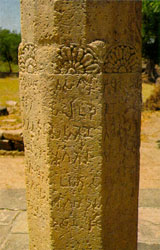
Heliodorus Inscription
The Greek king by the name of Antiochus, beyond whom live the four kings by the name of Ptolemy, the name of Antigonos, the name of Magas, the name Alexander.
The Greco-Bactrians (west of the Indus) and the Indo-Greeks (east of the Indus) were known for their high level of Hellenistic sophistication but kept regular contact with India. They were on friendly terms with India and exchanged ambassadors and thus ideas. One such ambassador was Heliodorus who was sent from Taxila to the court of King Bhagabhadra at Videsha (Besnagar, central India). Historians and scholars have recognized Heliodorus as the first western convert to the principles of Vaisnavism.
An inscription (2nd century BCE) attributed to Heliodorus found on a stone pillar at Besnagar reads as follows:
devadevasu vasudevasa garudadhvajo ayam
karito ia heliodorena bhaga
vatena diyasa putrena takhasilakena
yonadatena agatena maharajasa
amtalikitasa upamta samkasam-rano
kasiputrasa bhagabhadrasa tratarasa
vasena chatudasena rajena vadhamanasa
This Garuda-column of Vasudeva (Visnu), the god of gods, was erected here by Heliodorus, a worshipper of Visnu, the son of Dion, and an inhabitant of Taxila, who came as Greek ambassador from the Great King Antialkidas to King Kasiputra Bhagabhadra, the Savior, then reigning prosperously in the fourteenth year of his kingship.
There was also the Greek traveler and geographer Megasthenes (ca. 350 BCE – 290 BCE) who attended the court of Chandra Gupta as the ambassador of Seleucus I of Syria and who wrote in some detail about life in the kingdom of Chandra Gupta. There are accounts of Megasthenes having visited Mathura (on the banks of the Yamuna) and Madurai in the south (then, a bustling city and capital of Pandya Kingdom). His observations were recorded in Indika, a book that served as an important source to many later Greek writers such as Strabo (geographer) and Arrianus (historian).
Gold Coins of Agathocles
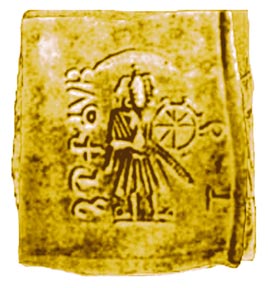
Vasudeva Krsna
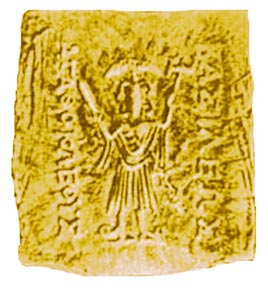
Balaram
However, the most famous archaeological discovery of the Indo-Greek period to show a unique blending of Indian and Greek cultures are the gold coins of Agathocles (2nd century BCE) bearing the images of Balarama holding the plow on one side and Vasudeva Krsna holding the disc on the other.
The contributions of the Greeks (Yavanas) to India were mainly absorbed in northwest India and included various social habits, dress, literature, art, striking coins, pottery, city planning, sculpture, open air theatre and so on. Even some classical Indian texts praise the Greeks for their scientific knowledge and contributions.
The Mahabharata compliments them as "the all-knowing Yavanas" (sarvajna yavana). The Brhat-Samhita of the mathematician Varahamihira says: "The Greeks, though impure, must be honored since they were trained in sciences and therein, excelled others.”
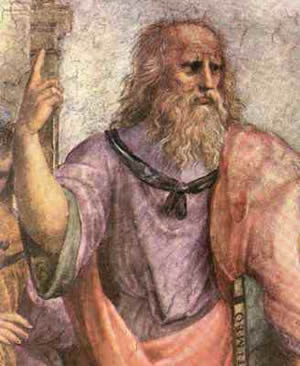
Greek Philosopher
That Greeks left their influence in India is certainly verifiable but that the Greeks as well as the rest of the world gained from India more than they gave is evident from the following statements made by notable personalities in history.
"Pythagoras went to the Ganges to learn geometry."
(Voltaire, writer and philosopher)
" We owe a lot to the Indians, who taught us how to count, without which no worthwhile scientific discovery could have been made."
(Albert Einstein, scientist)
KUSHANS
Next came the Kushans who ruled in India for some 150 years (circa 105 —250 CE). The Kushans conquered Tajikistan to Afghanistan, all of modern day Pakistan and the Punjab, down into the Ganges river valley in northern India and made Mathura (Vrndavana) their winter capitol. The Kushans originated in northwest China in what is now called Xinjiang and were known by the Chinese as Guishuang or Yuezhi. These were nomadic warlike people who after successful conquests settled down and became rulers, rulers of India.
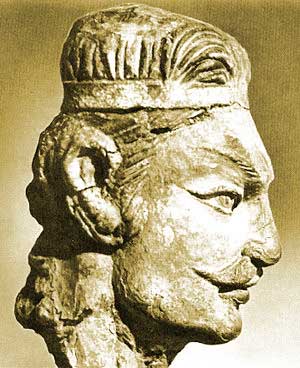
Stone Bust of Kushan King
The Kushans adopted the Greek alphabet Pali (Kharoshthi script), customs of the Afghans and north Indians and of course Buddhism, the then dominate religion in most of India. The throne of the Kushan rulers maintained diplomatic contacts with Rome, Persia and China. For several centuries they were at the center of exchange between the East and the West.
Although contributing to trade in India, one outstanding characteristic of the Kushans did not attract many if any indigenous people of India, the artificially deformed skull. The Kushans practiced tightly binding the foreheads of newborns so that the skull grew to be elongated. Although a mark of beauty and even royalty, the practice never caught hold in India.
Various sculptures and friezes of Kushans have been found representing horse-riding archers, and men with artificially deformed skulls. On the ruins of ancient Hellenistic cities such as Ai-Khanoum, the Kushans are known to have built fortresses in India and the earliest documented ruler, and the first one to proclaim himself as a Kushan ruler, was Heraios. He calls himself a ‘Tyrant’ on his coins, and also exhibits skull deformation.
In the beginning of their conquest many scholars believe that the Kushans adopted Zoroastrianism and then later Buddhism but soon came to adopt elements of Indian culture and religion. Some Kushan kings apparently even converted to Saivism. One has to wonder, what was going on in the Vraja during those times?
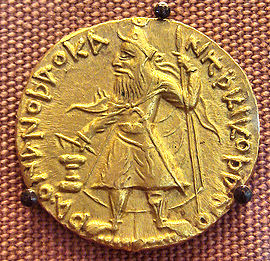
Kanishka
The recently discovered Rabatak inscription confirms a large Kushan empire under the great Kushan ruler, Kanishka as extending deep into the heartland of India. The inscription describes the cities which were under the rule of Kanishka, among which six names are identifiable: Ujjain, Kundina, Saketa, Kausambi, Pataliputra, and Champa. As late as the 3rd century CE, decorated coins of the Kushan ruler Huvishka were dedicated at Bodh Gaya together with other gold offerings under the ‘Enlightenment Throne’ of the Buddha, suggesting direct Kushan influence in the area during that period.
Kushan ruler Vima Kadphises was emperor from around 90–100 CE, the son of Sadashkana and the grandson of Kujula Kadphises, and the father of Kanishka I. He was the first to introduce gold coinage in India (or so it is believed), in addition to the existing copper and silver coinage. More than 30 different gods appear on Kushan coins belonging to the Hellenistic, the Iranian, and to the Indian religions.
The last of the ‘Great Kushans’ was Vasudeva I (191–225). He was the last great Kushan emperor, and the end of his rule coincides with the invasion of the Sassanids as far as northwestern India, and the establishment of the Indo-Sassanids or Kushanshahs from around 240 CE.
ETHIOPIANS
Possibly the most obscure history of foreign rule in India is that of Bengal which was ruled by Habshis from 1487 to 1493 CE. The name Habshi is an Arabic word for an Ethiopian or Abyssinian.Habshi rule began at the close of the reign of Sultan Jalaluddin Fath Shah. Shahzada, an Ethiopian eunuch and the leader of the Abyssinian slaves usurped the throne by murdering Jalaluddin Fath Shah in 1487.
The rule of the Habshis (Ethiopian slaves) lasted only six years during which four rulers, Barbak Shah Shahzada, Saifuddin Firuz Shah, Nasiruddin Mahmud Shah II and Shamsuddin Muzaffar Shah ruled Bengal.
On his accession Shahzada assumed the title of Sultan Barbak Shah. His rule was characterized by a policy of systematic elimination of opponents. This policy, however, could not save him and Malik Andil ultimately murdered him. Barbak Shah's rule lasted only six months.
Malik Andil, with the consent of the nobles, ascended the throne with the title of Saifuddin Abul Muzaffar Firuz Shah in 1487. The Persian chroniclers praised him highly for his benevolence and kindness to the poor and needy. He valued justice and liberality and made noble efforts to secure peace and comfort for his subjects. He was also a patron of arts and architecture. He either died a natural death or was secretly murdered in 1490 after a reign of only three years.
Nasiruddin Mahmud Shah II succeeded Saifuddin Firuz Shah. During his reign, Habash Khan grew in influence and this excited the jealousy of another Abyssinian slave named Sidi Badr Diwana, who ultimately killed Habash Khan and Mahmud Shah. Mahmud Shah's reign lasted a few months.
After the murder of Mahmud Shah II, Sidi Badr ascended the throne in 1490 AD and assumed the title of Shamsuddin Abu Nasr Muzaffar Shah. His reign was, for all practical purposes, a reign of terror. In order to get rid of his opponents, he slew many nobles and scholars. He exploited his subjects and collected revenue at extortionate rates, disbanded the greater part of his standing army and reduced the pay of his soldiers. Though a brute, Muzaffar Shah was not altogether a heartless tyrant. During his reign he devoted himself to the promotion of education and culture. He was said to be a patron of saints. His reign lasted only three years (1490 AD to 1493). His kingdom included the whole of north Bengal and some portions of Bihar.
The tyrannical rule of Muzaffar Shah alienated the people; Sayid Hussain, an Arab by descent and the chief minister of Muzaffar Shah organized a revolt and killed the sultan. With the murder of Muzaffar shah, Habshi rule in Bengal came to an end.
Sayid Hussain Shah (known also as the Nawab Hussain Shah) ruled Bengal between 1494 and 1538. His rule occupied a significant place in the medieval history of Bengal and he has been mentioned in Caitanya-caritamrta by Kaviraja Gosvami. The Nawab’s rule marked the zenith of the independent Sultanate in Bengal. His rule was characterized by territorial expansion, stabilization of administration and significant developments in religion, literature, the arts and the economy. This period marked the appearance of the yuga-avatara, Sri Caitanaya Mahaprabhu and the rise of the Bhakti cult in Bengal, Orissa, and Vrndavana. This period also saw the advent of the first Europeans in Bengal, signs of the new forces that were destined to shape the life of the country for centuries to come.
 Now in the 21st century India is under ‘home rule’, ruled by her own people and India has become the largest democracy in the world. But the stark reality of the situation is that western influence on moral conduct, material advancement and even religion, with the tremendous advances of Christianity within the country, is more than at any other time in history. Indians rule India, yet India is more prone to outside influences now than at any other time in history. What the Greeks and Kushans failed to do, what the Muslims and Moguls could not do in 1000 years of rule in India, what the British could not finish in 200 years, MTV and Bollywood have managed in only 62 years of independence — the massive moral, social and cultural degradation of India.
Now in the 21st century India is under ‘home rule’, ruled by her own people and India has become the largest democracy in the world. But the stark reality of the situation is that western influence on moral conduct, material advancement and even religion, with the tremendous advances of Christianity within the country, is more than at any other time in history. Indians rule India, yet India is more prone to outside influences now than at any other time in history. What the Greeks and Kushans failed to do, what the Muslims and Moguls could not do in 1000 years of rule in India, what the British could not finish in 200 years, MTV and Bollywood have managed in only 62 years of independence — the massive moral, social and cultural degradation of India.